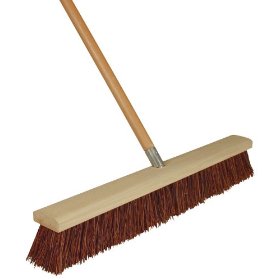Push_Brooms (Download)
Push Broom Safety 1 What is a Push-Broom? push broom – a wide broom that is pushed ahead of the sweeper ( websters on-line dictionary) Consists of a cylindrical elongated handle typically made of wood or fiberglass The handle connects to a block with bristles by a screw type fitting, sometimes strengthened with metal braces 2 History The push broom was an adaptation of the original invention of a broom which was used in ancient times to sweep out caves and castles. Before 1797 brooms were home made out of sticks and twigs. 3 History In 1797 Levi Dickenson made a broom using a variety of sorghum tassels. He was a farmer and was growing sorghum for the seeds. These tassels eventually were called “broom corn.” 4 History In 1810 a machine was invented to manufacture brooms, and this machine was an integral part of the industrial revolution. The broom has undergone changes/updates since then with one adaptation being the present day push broom. 5 Standard Push-Broom Uses Used in clean-up activities Used to push dirt, dust, and debris into piles for removal Used for finishing concrete surfaces 6 Push-Broom Operation The user grasps the handle with both hands With the bristles touching the floor, the user pushes the broom in a manner in which the bristles collect debris This action is repeated to form a pile of debris which will later be collected and discarded 7 Push Brooms in Construction As advances in safety are being made, the industry is realizing that jobsite cleanliness has a direct correlation to safe conditions on jobs. This makes the push broom a prevalent item on construction jobsites. 8 Typical Hazards/Safety Concerns A common hazard associated with extensive use of a push broom is blistering of the hands for workers using push brooms. 9 Typical Hazards/Safety Concerns Workers using a push broom may suffer “tunnel vision.” Workers are focused on their task and may not remember to look for and consequently overlook other hazards. Common hazards could be: Running into overhead objects (looking down causes workers to not look up to detect possible overhead dangers ) or stepping backwards into other obstructions 10 Venturing into unsafe areas If material is dry, stirring up dust may pose a hazard to respiratory functions Tripping hazards over material Slipping hazards Typical Hazards/Safety Concerns 11 Push-Broom Injury Data No data were found for injuries or fatalities that were a direct result of the use of push-brooms 12 Push Broom OSHA Regulations There are no OSHA regulations specifically mentioning the safe use of push brooms 13 PPE PPE should be worn at all times on jobsites and should always include: Safety vests Hard hats Safety glasses Long pants/sleeves Work boots 14 Additional PPE Specific for push brooms, workers should always wear gloves to avoid blisters . If using in an enclosed and dusty area a breathing mask should be worn to prevent particulates from entering the lungs 15 Push-Broom Safety An important safety aspect when using a push broom is to be aware of the surroundings . Workers tend to look down when they use a push broom , so it s important to always check to avoid entering unsafe work areas. 16 Think Safety Work Safely 17

